Difference Between Sleepsuit and Romper: Parents Boutique Owners Guide
Many parents get confused when shopping for infant clothing because the terms sleepsuit and romper are often used interchangeably. Understanding the difference between sleepsuit and romper helps you pick the right outfit for your baby’s comfort, mobility, and seasonal needs. A sleepsuit is a one-piece garment covering arms, legs, and sometimes feet, designed for nighttime warmth and sleep, while a romper is lighter, often short-sleeved or sleeveless, and ideal for daytime play and mobility.
In this guide, you will learn how each garment differs, when to use them, fabric and safety considerations, and why boutiques benefit from stocking both for newborns and toddlers.
1. What Is a Sleepsuit?
A sleepsuit is a one-piece garment designed for infants, covering the arms, legs, and often the feet. Its main purpose is to keep babies warm and comfortable during sleep. Sleepsuits can also reduce the need for loose blankets that can pose a safety risk.
Key Features
- Closures: Poppers or zips for quick diaper changes.
- Fabric: Soft cotton, organic cotton, or fleece for colder seasons.
- Coverage: Full body, including footed options for extra warmth.
Typical Use
- Nighttime sleep: Ideal for newborns and infants during naps or bedtime.
- Cooler weather: Provides warmth without layering multiple items.
- Newborn stage: Suits babies 0–3 months, though sizes extend up to 12 months.
Parents looking for baby sleepsuit clothing often choose styles that are breathable, soft, and easy to manage. Footed sleepsuits are particularly practical for winter months, which offer added protection and comfort while sleeping.
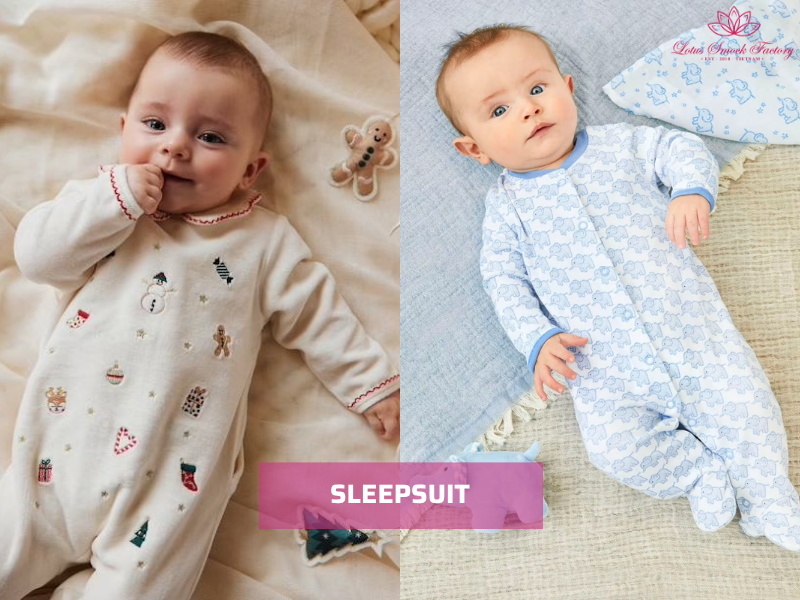
2. What Is a Romper?
A romper is a one-piece outfit that combines a top and shorts, designed primarily for daytime wear. Rompers allow freedom of movement, making them ideal for playtime and casual outings.
Key Features
- Fabric: Lightweight materials such as cotton, linen, or jersey for breathability.
- Closures: Easy snaps at the crotch for quick diaper changes.
- Design: Short-sleeved or sleeveless to keep babies cool during warmer weather.
Typical Use
- Daytime wear: Perfect for casual activities, family outings, or playdates.
- Warm weather: Keeps babies comfortable without overheating.
- Active infants: Designed for babies 6 months and older who are crawling or walking.
Parents often look for baby romper suits or toddler rompers that combine comfort with practical design. Rompers provide versatility and mobility while keeping babies stylish and cool for everyday wear.
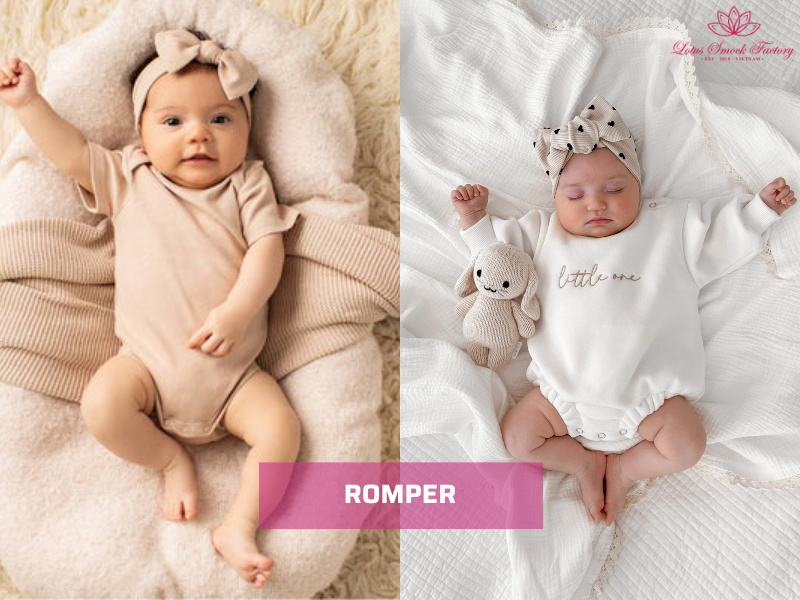
3. Key Differences Between Sleepsuit and Romper
When parents understand the difference between sleepsuit and romper, they can choose the right outfit for their baby’s needs. While both are one-piece garments, they serve distinct purposes depending on time of day, season, and activity level.
| Feature | Sleepsuit | Romper |
| Length | Long sleeves & legs | Short sleeves / short legs |
| Coverage | Often includes feet | Leaves legs exposed |
| Use | Nighttime, cooler seasons | Daytime, warmer seasons |
| Fabric | Cotton, fleece, brushed knit | Cotton, linen, jersey |
| Age Suitability | Common for newborns | Great for 6M+ active babies |
Comfort & Safety:
Sleepsuits provide full-body warmth, making them ideal for nighttime or cooler months. Rompers allow freedom of movement, perfect for active babies during playtime or outings.
Seasonal Choice:
Choose sleepsuits in winter or cold weather to keep babies cozy. Rompers are better for summer or warmer climates, allowing breathability and comfort.
Practicality for Parents:
Rompers make diaper changes easier thanks to crotch snaps, while sleepsuits are more convenient for overnight use, keeping the baby warm without extra layers.
By understanding these differences, parents can confidently select between sleepsuits and rompers to meet both comfort and practicality needs for their baby.
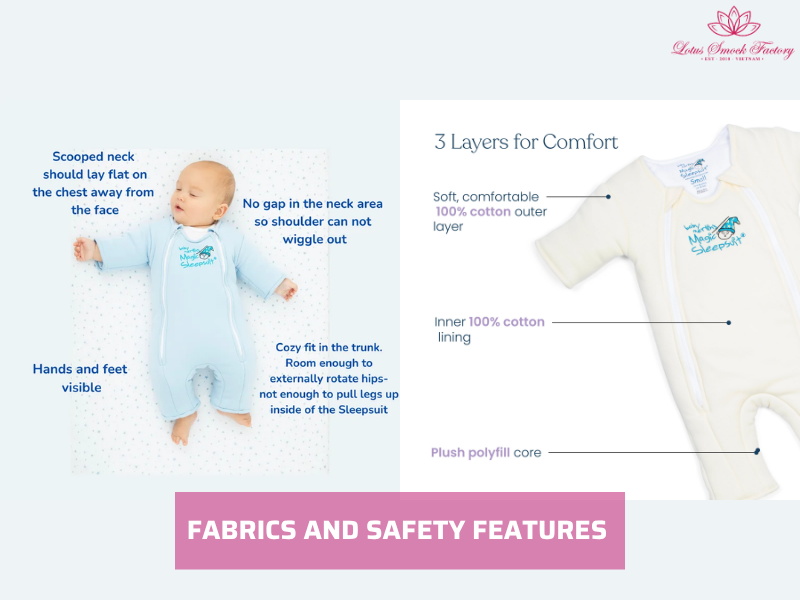
4. When Should You Choose a Sleepsuit vs a Romper?
Parents can select and dress their babies appropriately for comfort and safety when choosing the right a sleepsuit or a romper.
Sleepsuits are best for bedtime, naps, or travel in cooler weather. They provide full coverage, often including feet, which helps regulate body temperature and keeps newborns cozy. Fabrics like cotton, fleece, or velour are common, offering warmth while remaining soft against sensitive skin.
Sleepsuits are ideal for:
- Bedtime or naps, providing full-body coverage and warmth.
- Travel in cooler weather, ensuring the baby stays cozy in cars, strollers, or overnight stays.
- Newborns and infants benefit from footed options and soft, insulating fabrics.
In contrast, Rompers are best for playtime, family outings, and warmer days. Lightweight fabrics such as cotton, linen, or jersey keep babies comfortable and allow freedom of movement. Short sleeves and legs make rompers suitable for active babies six months and older.
Rompers are best for:
- Daytime play and family outings give babies freedom of movement.
- Summer or warmer climates, where breathable fabrics like cotton or linen keep babies comfortable.
- Active infants, who are crawling, walking, or exploring their environment.
By following a day vs night baby clothes approach, parents can dress babies appropriately for comfort and safety, while boutiques benefit from a seasonal baby outfit guide that appeals to both practical and premium buyers.
=>>> Check how to keep your baby comfortable in different seasons with our guides: [How Do You Dress a Newborn in Summer?] and [How Do You Dress a Newborn in Winter?], so you know when to choose a romper or a sleepsuit.
5. Seasonal and Age Considerations
When choosing between a sleepsuit and a romper, parents should consider both their baby’s age and the season. Different garments suit different stages of growth and weather conditions, helping keep infants comfortable and safe. The details of the age range are below:
Newborns (0–3 months):
- Safer and warmer in sleepsuits, especially footed styles.
- Ideal for nighttime sleep or cooler environments.
- Provides full coverage to reduce exposure to drafts.
6–12 months:
- Mix rompers for daytime wear and sleepsuits at night.
- Rompers allow mobility for crawling and play, while sleepsuits maintain warmth during naps.
- Parents can layer lightweight tops under rompers for transitional seasons.
Toddlers (1–3 years):
- Rompers remain excellent for active movement during the day.
- Footed or fleece sleepsuits are suitable for cozy winter nights or naps.
Regional Differences:
- In the US, warmer climates favor rompers for longer periods, while northern regions require sleepsuits during colder months.
- In the UK, parents often use sleepsuits year-round for overnight warmth and rompers primarily for indoor play.
Parents consider age and season, which helps to select the right combination of sleepsuits and rompers, balancing comfort, mobility, and temperature regulation.
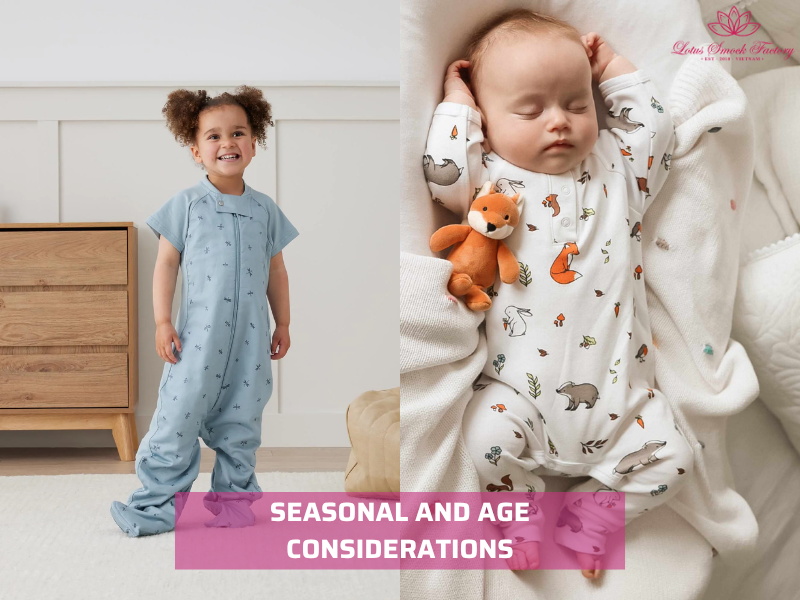
=>>> For boutique owners, explore our [Top 10+ Smocked Pyjamas Wholesale Models for Your Boutique] to stock both sleepsuits and rompers, offering parents practical and stylish options for daytime play and nighttime warmth.
6. Common Mistakes Parents Should Avoid
Parents often make simple mistakes when choosing between sleepsuits and rompers, which can affect a baby’s comfort and safety.
- Using rompers as sleepwear in winter: Rompers usually have short sleeves or legs, leaving babies exposed to cold. Choosing a footed sleepsuit during colder nights helps maintain body warmth and reduces the risk of chills.
- Over-layering under sleepsuits: Adding too many layers beneath a sleepsuit can cause overheating, which is unsafe for newborns. Parents should select breathable fabrics like cotton or organic cotton and avoid heavy blankets inside the sleepsuit.
- Confusing rompers with bodysuits/onesies: Many parents assume all one-piece garments are the same. Rompers are designed for daytime mobility, while bodysuits or onesies provide a base layer for warmth or layering. Misusing them can reduce comfort and complicate diaper changes.
Understanding romper vs sleepsuit helps parents make informed clothing choices for each age, activity, and season, keeping babies safe, warm, and comfortable.
7. How to Buy the Right Sleepsuit or Romper for Your Baby
When buying, parents should select the right sleepsuit or romper that ensures comfort, safety, and practicality for their baby.
Parents should choose the right fabric for the season, including:
- Use cotton for everyday wear; it is soft, breathable, and easy to wash.
- Choose fleece for winter sleepsuits to provide extra warmth during colder nights.
- Opt for linen or lightweight cotton for summer rompers to keep babies cool while playing.
Parents should pick the right sizes:
- Select sizes that allow freedom of movement without being too loose.
- Check that arms, legs, and torso have enough space for crawling or stretching.
Consider safety features to keep babies safe and comfortable, including:
- Avoid garments with scratchy seams that could irritate sensitive skin.
- Ensure snaps and zips are high-quality and securely attached to prevent accidents.
Boutique Buying Tips:
- Stock a range of sizes from 0–24 months to cover newborns to toddlers.
- Offer seasonal themes and colors, combining sleepsuits for nighttime and rompers for daywear.
By following these tips, parents can choose the best baby sleepsuit and baby romper outfit ideas for comfort, safety, and style, while boutiques can curate a versatile collection that meets customer needs.
8. Guide for Shop Owners / Boutique Buyers
For boutique owners, stocking both sleepsuits and premium smocked outfits is a smart strategy to reach a broader customer base. While basic sleepsuits cater to parents seeking practical and comfortable daily wear, hand-smocked dresses, rompers, and seasonal pieces attract customers looking for heirloom-quality clothing for photos, holidays, and gifting occasions.
8.1. Why Boutique Owners Should Stock These Items
Boutique owners can benefit in multiple ways:
- Seasonal Relevance: Smocked outfits sell particularly well during holidays and special occasions, boosting revenue during peak periods.
- Upselling Opportunities: Pairing basic sleepsuits with smocked dresses or rompers allows boutiques to increase average order value through coordinated sets or sibling bundles.
- Customer Loyalty: Offering high-quality, customizable clothing encourages repeat purchases from parents who value exclusive and personalized designs.
- Differentiation: Handcrafted smocked clothing distinguishes boutiques from mass-market retailers and fast-fashion stores.
- Social Media Appeal: Photogenic designs are perfect for shareable content, enhancing boutique visibility online.
8.2. Lotus Smock – Wholesale Smocked Clothing Factory
Boutique owners can stock premium, handcrafted baby clothing from Lotus Smock, including sleepsuits, smocked outfits, and seasonal collections. Lotus Smock offers:
- Low MOQs of 30 pieces per style for flexible ordering
- Free 2D design mockups for pre-order previews
- Custom embroidery, monograms, and sibling sets for boutique exclusivity
- 30–35 day production turnaround plus 5–7 day FedEx shipping
Whether stocking summer, winter, or holiday collections, Lotus Smock delivers ready-to-sell, high-quality options that combine craftsmanship, versatility, and boutique appeal. By offering these items, boutiques give parents both practical and premium choices, increasing sales and building a trusted reputation.
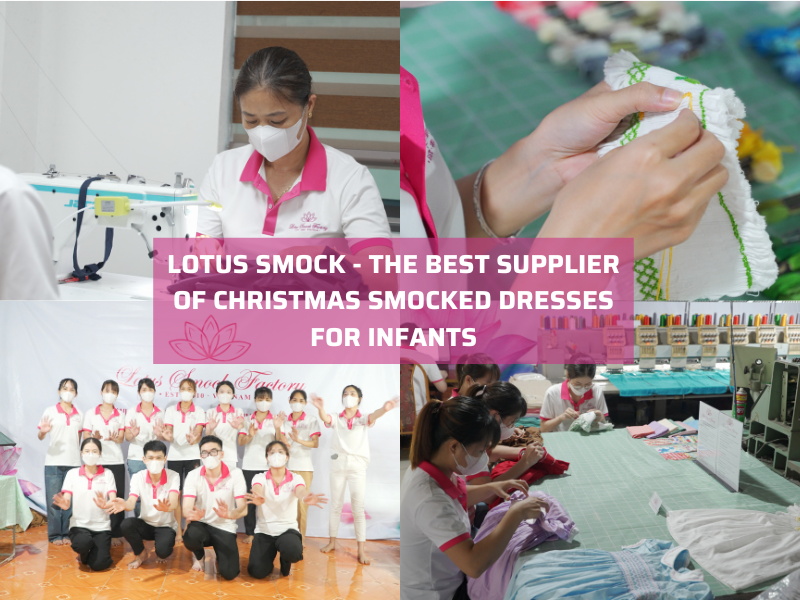
Contact Lotus Smock to Start Your Halloween Order:
- Facebook: facebook.com/lotussmockfactory
- WhatsApp: +84 83 333 3498
- Youtube: youtube.com/@LotusSmockFactory
Learn more about Lotus Smock – Wholesale Smocked Clothing Factory, High Quality Hand Smocked Dresses HERE.
9. FAQs
Q1: Can a baby sleep in a romper at night?
Yes, a baby can sleep in a romper if the fabric is soft and breathable, and the room temperature is comfortable. However, sleepsuits are generally better for overnight warmth, especially during cooler months, because they cover the arms, legs, and sometimes feet.
Q2: Are sleepsuits only for newborns?
No. Sleepsuits are suitable for newborns and infants up to about 12 months. Footed or long-sleeved styles keep babies warm during sleep or travel. Older toddlers may prefer footless styles or transition to rompers or bodysuits for mobility.
Q3: What’s the difference between a bodysuit and a romper?
A bodysuit only covers the torso and snaps at the crotch, mainly used for layering or under outfits. A romper covers the torso and legs (short or long) and is designed for daytime play, comfort, and mobility.
Q4: Can rompers be worn in winter with layers?
Yes. Pair rompers with long-sleeve onesies, tights, or a sleepsuit over it to keep the baby warm. Layering allows flexibility for indoor and outdoor conditions.
Q5: Are sleepsuits gender-neutral?
Yes. Sleepsuits come in neutral colors and patterns suitable for any baby, making them versatile for gifting or multiple children in a household.
10. Final Words
Knowing the difference between sleepsuit and romper allows parents to choose clothing that matches their baby’s age, activity, and weather. Sleepsuits provide warmth and coverage for sleep or cooler conditions, while rompers offer freedom of movement for playtime and daytime outings.
Boutiques can use this knowledge to stock a balanced selection, educate customers, and optimize sales. By combining practical basics with seasonal or premium items, you give parents more options and ensure comfort and style for babies.

